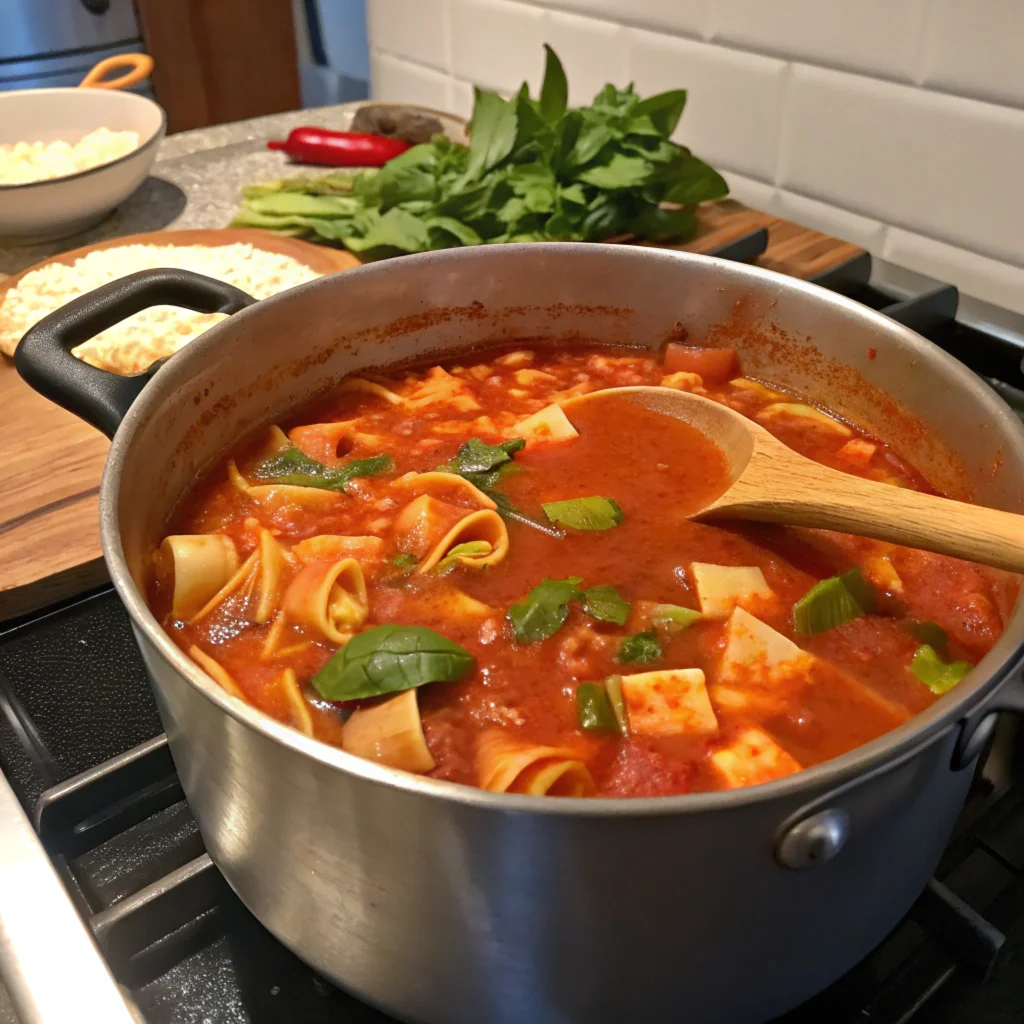Introduction to Lasagna Soup
Vegetarian Lasagna soup offers the hearty, comforting flavors of traditional lasagna in a quick, one-pot recipe. It’s perfect for busy weeknights or when you crave a cozy, warm dish. With layers of flavor from rich tomato broth, tender pasta, and creamy cheese, this dish is sure to become a family favorite.
What sets this recipe apart is its vegetarian twist, making it accessible to a wide range of diets. Whether you’re a committed vegetarian or just looking to reduce your meat intake, vegetarian lasagna soup provides all the satisfaction of its classic counterpart, minus the meat.
In this guide, you’ll learn everything from the essential ingredients to expert tips that guarantee the perfect bowl of lasagna soup. Let’s dive in!
Why You’ll Love This Vegetarian Lasagna Soup Recipe
This vegetarian lasagna soup recipe isn’t just delicious; it’s also:
- Convenient: All the flavors of lasagna without the hassle of layering.
- Healthy: Packed with vegetables, it’s a nutritious option for any meal.
- Customizable: Adapt it to suit vegan diets, spice preferences, or additional protein sources.
- Comforting: Perfect for chilly evenings or when you need a wholesome meal.
- Family-Friendly: Loved by kids and adults alike.
Transitioning from traditional lasagna to this soup version is not only quicker but also eliminates the need for oven baking. Plus, the inclusion of fresh vegetables and herbs gives it a lighter yet satisfying flavor profile.
Also Read: Lasagna Soup in Crockpot – Hearty and Easy to Make
Ingredients Needed for Vegetarian Lasagna Soup
Key Ingredients for the Base
The base ingredients are the foundation of this vegetarian lasagna soup. Here’s what you’ll need:
- Vegetable Broth: Provides a flavorful base for the soup.
- Crushed Tomatoes: For that rich tomato flavor essential to lasagna.
- Onion and Garlic: Aromatic staples that enhance the overall flavor.
- Carrots and Celery: Add a subtle sweetness and depth to the soup.
- Dried Italian Seasoning: Brings the classic lasagna spices like basil, oregano, and thyme.
- Lasagna Noodles: Broken into bite-sized pieces to mimic lasagna layers.
- Ricotta, Mozzarella, and Parmesan Cheese: These add creaminess and that classic cheesy lasagna taste.
Optional Add-Ins
To enhance your vegetarian lasagna soup, consider these optional ingredients:
- Spinach or Kale: For extra greens and a nutritional boost.
- Red Pepper Flakes: Add a spicy kick to the dish.
- Zucchini or Mushrooms: Introduce more texture and earthy flavors.
- Plant-Based Meat Crumbles: For a heartier meal without compromising vegetarian principles.
- Fresh Herbs: Parsley or basil can brighten the soup with fresh, aromatic notes.
How to Make Vegetarian Lasagna Soup: Step-by-Step Instructions
Step 1: Prepare the Vegetables
Start by prepping your vegetables. Dice the onions, carrots, and celery into small, uniform pieces to ensure even cooking. Mince the garlic for maximum flavor release during cooking. If adding zucchini or mushrooms, slice them into thin pieces.
- Tip: Use fresh, high-quality vegetables to enhance the soup’s flavor and nutritional value.
- Keyphrase Use: Fresh vegetables are essential for a robust vegetarian lasagna soup.
Step 2: Cook the Aromatics
In a large pot, heat olive oil over medium heat. Add the onions, carrots, and celery, cooking until softened. Stir in the garlic and Italian seasoning, allowing the spices to bloom for about 1-2 minutes.
- Transition Note: After this step, your kitchen will start to smell amazing.
- Keyphrase Use: Aromatics lay the groundwork for a flavorful vegetarian lasagna soup.
Step 3: Simmer the Soup

Pour in the vegetable broth and crushed tomatoes, then bring the mixture to a simmer. Add the broken lasagna noodles and cook until they are tender. Stir occasionally to prevent sticking.
- Tip: Keep an eye on the pasta, as overcooking can make it mushy.
- Keyphrase Use: Simmering is where the magic happens in a vegetarian lasagna soup.
Step 4: Add Cheese and Serve
Once the noodles are cooked, stir in the cheese. Ricotta adds creaminess, while mozzarella and parmesan create a gooey, melty texture. Serve hot, garnished with fresh basil or parsley.
- Tip: Layer the cheese into each bowl for an authentic lasagna experience.
- Keyphrase Use: The cheese is what transforms this into a true vegetarian lasagna soup.
Tips for Making the Best Vegetarian Lasagna Soup
By following these expanded tips, you’ll be equipped to create the most delicious and satisfying vegetarian lasagna soup every time.
Use Fresh Ingredients: Fresh vegetables and herbs can elevate the flavor of your vegetarian lasagna soup significantly. Ingredients like ripe tomatoes, freshly minced garlic, and vibrant green basil make a noticeable difference. Freshly grated parmesan or mozzarella can also improve the texture and flavor of the soup compared to pre-packaged shredded cheese.
Tip: Visit your local farmer’s market to source seasonal vegetables for the best flavor and nutritional value.
Why It Matters: Fresh ingredients ensure your soup tastes vibrant and well-rounded, setting it apart from recipes relying on processed or canned items.
Don’t Overcook the Pasta: Cooking the lasagna noodles to al dente is crucial for achieving the right texture. Overcooked noodles can become mushy and disintegrate into the soup, altering the consistency. Break the lasagna noodles into smaller, bite-sized pieces before cooking them in the broth.
Tip: Set a timer while cooking the pasta to avoid overcooking. Taste test for doneness starting at the lower end of the suggested cooking time.
Why It Matters: Properly cooked pasta maintains a pleasant bite and enhances the overall experience of the soup.
Taste as You Go: Adjusting seasoning levels throughout the cooking process is essential to ensure a balanced flavor profile. Adding too much salt early on or forgetting to taste the soup before serving can lead to a less enjoyable meal.
Tip: Add small amounts of salt, pepper, or spices incrementally and taste frequently to fine-tune the seasoning.
Why It Matters: Tasting and adjusting as you go ensures every spoonful of soup is flavorful and balanced.
Make it Ahead: Vegetarian lasagna soup often tastes better the next day as the flavors have more time to meld together. This makes it an excellent dish to prepare ahead for gatherings or meal prepping.
Tip: Let the soup cool completely before storing it in an airtight container in the refrigerator. Reheat gently on the stove to preserve the texture.
Why It Matters: Preparing the soup in advance allows the flavors to deepen, resulting in a richer and more satisfying dish.
Store Separately: If you’re planning to store leftovers, keep the noodles and soup base in separate containers. Combining them can cause the pasta to absorb too much liquid, resulting in soggy noodles.
Tip: Add cooked noodles to individual servings just before reheating.
Why It Matters: Separating the components ensures the soup maintains its texture and consistency for future meals.
Use a High-Quality Broth: A flavorful vegetable broth is the backbone of your soup. Opt for a low-sodium variety to control the salt levels and allow the other ingredients to shine. Homemade vegetable broth can take this dish to the next level.
Tip: If using store-bought broth, enhance it with a splash of soy sauce or a pinch of nutritional yeast for added depth.
Why It Matters: A high-quality broth ensures every component of the soup is flavorful and cohesive.
Experiment with Layers of Cheese: The blend of ricotta, mozzarella, and parmesan cheese is key to recreating the classic lasagna experience. Experiment with the proportions to find your ideal balance. For example, add extra ricotta for creaminess or more parmesan for a nutty flavor.
Tip: Layer the cheeses directly into the bowl before ladling hot soup over them for a restaurant-quality presentation.
Why It Matters: The cheese layer ties the dish together and gives it the indulgent quality of traditional lasagna.
Garnish for Extra Flavor: Adding a garnish like fresh basil, parsley, or a drizzle of olive oil can elevate the dish. These final touches not only enhance the flavor but also improve the presentation.
Tip: Use freshly grated parmesan as a finishing touch for an added layer of richness.
Why It Matters: Garnishes make the soup look appealing and add bursts of fresh flavor to every bite.
Variations and Customizations for Vegetarian Lasagna Soup
Vegan Version
To make this vegetarian lasagna soup vegan, replace dairy cheeses with plant-based alternatives. Nutritional yeast can also add a cheesy flavor.
- Tip: Coconut cream or cashew cream works well for added richness.
Add Protein with Legumes
For extra protein, include cooked lentils, chickpeas, or white beans. These legumes blend seamlessly into the soup while boosting its nutritional profile.
- Keyphrase Use: Adding protein enhances the heartiness of vegetarian lasagna soup.
Spice It Up
If you enjoy spice, add red pepper flakes, cayenne pepper, or hot sauce. This variation complements the rich, cheesy base.
- Tip: Adjust spice levels gradually to avoid overpowering the dish.
FAQs About Vegetarian Lasagna: Answers to Your Most Common Questions
What Can I Use Instead of Meat for Lasagne?
If you’re making a vegetarian lasagna, there are plenty of delicious alternatives to meat that will still give you a hearty and satisfying dish:
- Plant-Based Proteins: Use lentils, chickpeas, or crumbled tofu for a protein boost.
- Vegetables: Mushrooms, zucchini, and eggplant can add a rich, meaty texture.
- Meat Substitutes: Products like plant-based ground “meat” or textured vegetable protein (TVP) work well.
- Cheese: Ricotta and mozzarella can add creaminess, while parmesan provides a savory depth.
These alternatives ensure your lasagna remains flavorful and filling without compromising its texture or taste.
How Do You Make Vegetarian Soup Less Bland?
Vegetarian soups can sometimes lack depth, but with the right ingredients and techniques, you can create a flavorful soup:
- Season Generously: Use salt, pepper, and herbs like basil, oregano, and thyme to enhance the flavor.
- Add Aromatics: Sauté onions, garlic, and celery to build a flavor-packed base.
- Use High-Quality Broth: Opt for a flavorful vegetable broth or make your own.
- Incorporate Umami: Add a splash of soy sauce, nutritional yeast, or miso paste for depth.
- Finish with Acid: A squeeze of lemon juice or a splash of vinegar brightens the flavor.
With these tips, your vegetarian soup will be anything but bland.
How Do You Keep Veggie Lasagna from Getting Soggy?
To prevent your veggie lasagna from becoming too watery, follow these tips:
- Roast or Sauté Vegetables: Cook your vegetables before layering to reduce their moisture content.
- Drain Ricotta: If using ricotta cheese, strain it to remove excess liquid.
- Use Less Sauce: Avoid overloading your lasagna with too much tomato sauce.
- Layer Properly: Alternate between dry and wet layers to maintain balance.
- Rest Before Serving: Allow the lasagna to rest after baking, so it sets properly.
These steps will ensure your lasagna holds its structure and remains flavorful.
What Is the Best Vegetable to Go with Lasagna?
Several vegetables pair beautifully with lasagna, adding both flavor and nutrition:
- Spinach: Its mild flavor complements the richness of lasagna.
- Mushrooms: Add an earthy, meaty texture.
- Zucchini: Light and slightly sweet, it blends well into the dish.
- Eggplant: A classic Italian favorite that’s hearty and satisfying.
- Bell Peppers: For a touch of sweetness and crunch.
These vegetables can be incorporated into the lasagna or served on the side as a complementary dish.
What Do Italians Serve with Lasagne?
In traditional Italian meals, lasagne is often paired with simple, fresh sides that enhance the flavors of the main dish:
- Green Salad: Tossed with olive oil and balsamic vinegar.
- Garlic Bread: A classic pairing to soak up the sauce.
- Grilled Vegetables: Lightly seasoned and cooked to perfection.
- Caprese Salad: Fresh tomatoes, mozzarella, and basil drizzled with olive oil.
These sides keep the meal balanced and allow the lasagna to shine as the centerpiece.
Is Lasagna Better with Ricotta or Cottage Cheese?
The choice between ricotta and cottage cheese comes down to personal preference and texture:
- Ricotta: Creamy and smooth, it’s the traditional choice for lasagna.
- Cottage Cheese: Lower in fat and slightly tangy, it’s a lighter alternative.
For a middle ground, blend cottage cheese to achieve a texture closer to ricotta. Both options work well in vegetarian lasagna, depending on your desired flavor and texture.
Does Traditional Lasagna Have Vegetables?
Traditional lasagna recipes typically feature layers of pasta, meat, tomato sauce, and cheese. However, many classic Italian versions also include vegetables:
- Spinach: Often added to the ricotta mixture.
- Eggplant or Zucchini: Common in Southern Italian recipes.
- Carrots and Celery: Used in the base of the sauce for added sweetness and depth.
While not always the focus, vegetables are frequently included to enhance the dish’s flavor and texture. In vegetarian versions, vegetables often take center stage.
Conclusion
Vegetarian lasagna soup is a delightful twist on a beloved classic, offering comfort, nutrition, and endless versatility. With simple ingredients and step-by-step guidance, it’s an approachable recipe for cooks of all levels. Whether you’re seeking a cozy family dinner or a dish to impress guests, this recipe checks all the boxes.
Experiment with the suggested variations, and don’t forget to savor every comforting spoonful. This soup isn’t just a meal—it’s an experience.






